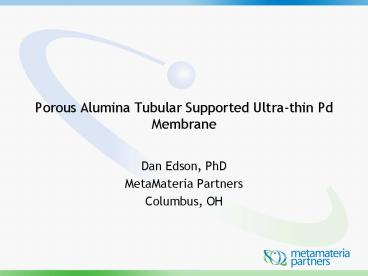Porous Alumina Tubular Supported Ultra-thin Pd Membrane - PowerPoint PPT Presentation
1 / 21
Title: Porous Alumina Tubular Supported Ultra-thin Pd Membrane
1
Porous Alumina Tubular Supported Ultra-thin Pd
Membrane
- Dan Edson, PhD
- MetaMateria Partners
- Columbus, OH
2
Acknowledgements
- DOE for 1 year of funding for hydrogen work
- EMTEC, Dayton, OH - Program administration
- NanoDynamics Inc, Buffalo, NY Addition Funding
- The Ohio State University Team members
- Professor Henk Verweij
- Krenar Shqua Post-doc
- William Chiu Graduate student
- MetaMateria Partners
- Dr. Dick Schorr
- Dr. Suv Sengupta
- Dr. Rao Revur
- Troy Pyles
- Nancy Falcon
3
Outline
- Overview
- Background of hydrogen program
- Description of forming method
- Approach for multilayer membrane
- Properties of supports
- Properties of intermediate layers
- Properties of electroless Pd membrane layer
- Future Work
- Conclusions
4
Overview
- This project used capabilities at MetaMateria
Partners and Ohio State University to prepare
hydrogen membrane - MetaMateria Capabilities
- Novel method for preparing porous ceramic support
tubes - Colloids for preparation of thin film membranes
- Ohio State Capabilities
- Experience with preparation characterization of
thin membranes - Membrane Developed
- Uses two thin intermediate layers, a dense,
gas-tight palladium membrane layer deposited onto
alumina supports via electroless deposition with
a thickness of 250 nm. - Measured hydrogen permeability of the composite
membrane is 1x10-6 mol/(m2sPa) 6x10-4
mol/(m2sPa1/2) at 320C.
5
Background on Work
- Development funded through DOE for
commercialization of a high-flux, highly
selective hydrogen separation membrane - Approach combined supported inorganic membrane
technology developed by Prof. Henk Verweij and
team at The Ohio State University using a planar
geometry with a high-quality porous ceramic
cathode tubular support and colloids developed by
MetaMateria that uses a novel colloidal method
(MMCP) - Development also uses core technologies at
MetaMateria for producing clear nanoparticle
dispersions and nanostructuredthin films from
these dispersions.
6
Benefits of MMCP Forming Method
- Low-cost, low-organic, water-based ceramic
forming method (MMCP) used with low-pressure
injection molding - Thermo-reversible binder system
- enables demolding 2-5 minutes following injection
- 2-3 weight percent total organic content
- Short debind cycle time
- Colloidal processing methods improve part
uniformity - Highly interconnected porosity following drying
- Binder system is used for several ceramic
materials - Al2O3, ZrO2, YSZ, LSM, SiC, B4C, SiO2
- Traditional processing parameters
- pH, surfactants, particle size distributions,
sintering aids, etc. - Dense or porous ceramic parts can be produced
7
Examples of MMCP Parts
8
Multi-layer Membrane Approach
- Standard architecture maximizes flux by
minimizing thickness of lower-permeability layers - Subsequent layers must be thicker than largest
defect in previous layer - Processing control determines attainable
performance - Benefits
- Strong carrier
- Reduced Pd costs
- Limited metallic inter-diffusion/poisoning
- High H2 permeability
9
Approach - continued
- Developed a sintered macro-porous (gt1 micron
gt30 porous) alumina support tube 10 cm in length
using MMCP and low-pressure injection molding - Transfer technology from OSU on using aqueous
ceramic suspensions for the intermediate layers - Use OSU-developed method for deposition of dense,
ultra-thin (200-300 nm) Pd membrane layer - OSU conducted performance testing, which was
limited due to time/budget constraints
MMP porous alumina supports
10
Properties of Supports Hg porosimetry
C
- Volume of porosity is about 36 in final
supports - Pore size can be controlled by MMCP method and
exhibits a sharp mono-modal size distribution
B
A
11
Microstructure of Supports - Fracture
- Porosity controlled by particle interstices
rather than more exotic pore forming methods to
minimize defects which would need to be repaired
12
Dip-Coated Intermediate Layers
- Two alumina intermediate layers designed to
reduce pore size to 80 nm then 4 nm. - Thickness of 1st layer about 8 microns
- Thickness of second layer lt1 micron
FIB cross-section
13
80 nm Pore Size in Intermediate Layer
80 nm peak
14
Intermediate Layers on Supports
Planar
Tubular
15
Minimal Impact on Permeability
16
Patent-Pending Electroless Deposition
- Electroless deposition is a standard method to
create a dense palladium membrane layer. - OSU developed electroless deposition method for
making a continuous, gas-tight palladium layer
that develops in 5 to 10 minutes (thickness of
200 to 300 nm)
(500 nm bar)
5 minutes for deposition
(5 micron bar)
17
Pd Membrane Cross-Section (285 nm thick)
Pd layer
(2 micron bar)
2nd intermediate layer
1st intermediate layer
(500 nm bar)
18
Photograph of 10 cm Membrane
- Glass coatings at ends to improve sealing during
testing
19
Permeance/Selectivity Data
- Best literature value is 9.6x10-4
mol/(m2sPa1/2) at 500C for a membrane on a
macroporous stainless steel tube. (Tong et al, J.
Mem. Sci. 260 (2005)) - At 320C same membrane had permeance of about
3.7x10-4 mol/(m2sPa1/2). - Permeance value of the MMP/OSU membrane at 320C
is 6x10-4 expressed in the same units
mol/(m2sPa1/2).
20
Looking to the Future
- Hydrogen work on hold while looking for funding
partners for this promising approach - Proposal pending for additional STTR DOE funding
- Investigating alternate industrial funding to
further develop porous ceramics and membranes for
other water, fluid and/or gas separation
applications - Anticipate that use of Pd-alloys will improve
transport values and overcome lifetime issues as
reported by others - Much further testing and development needed
21
Conclusions
- Capability to prepare high-quality, porous
ceramic tubular supports using low-organic,
aqueous-based ceramic processing demonstrated - Addition of intermediate layers via dip-coating
demonstrated to produce graded pore structure
which exhibited minimal impact on gas transport
properties - Development and deposition of high-selectivity,
ultra-thin Pd membrane - Higher performance observed than any other Pd
membrane found in literature - Gas-tight at RT for nitrogen suggests quality of
Pd layer and underlying support layers - Porous supports useful for wide range of
separation applications































